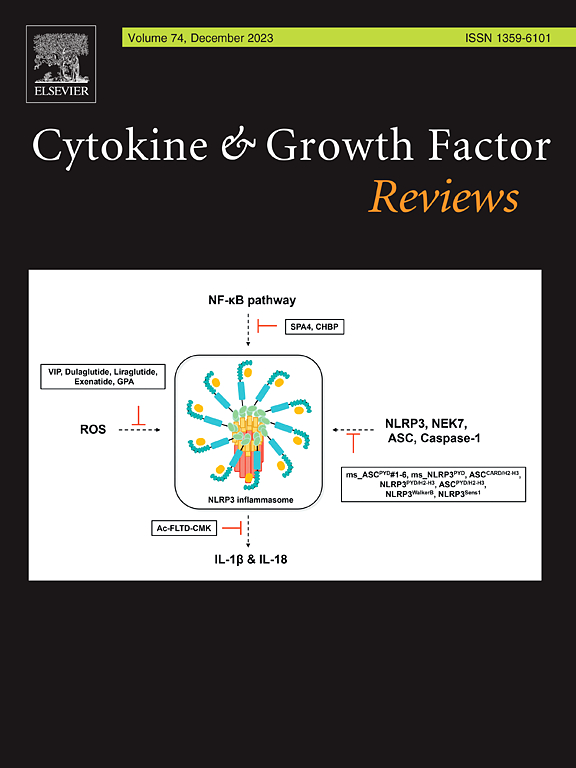神经退行性疾病中的 NLRP1 炎症小体:从病理学到疗法
IF 11.8
2区 医学
Q1 BIOCHEMISTRY & MOLECULAR BIOLOGY
引用次数: 0
摘要
神经炎症是神经退行性疾病的重要组成部分。炎性体促进了 caspase-1 的裂解,导致炎性因子白细胞介素(IL)-1β 和 IL-18 的成熟和随后分泌。因此,由 gasdermin D 介导的脓毒症会加剧神经炎症。虽然 NLRP1 是最早被发现的炎性体,但 NLRP1 在神经退行性疾病中的具体参与仍有待全面阐明。最近,NLRP1 的内源性抑制剂--二肽基肽酶 9 的发现表明,生产针对 NLRP1 的小分子药物是可行的。本综述介绍了有关 NLRP1 炎症小体在神经退行性疾病(包括阿尔茨海默病)病理学中作用的最新发现,并总结了 NLRP1 炎症小体在中枢神经系统中激活的调控机制。此外,我们还重点介绍了最近在开发调节 NLRP1 炎症小体的小分子和生物抑制剂以治疗神经退行性疾病方面取得的进展,其中一些抑制剂已进入临床前测试阶段。意义声明:本综述旨在总结有关 NLRP1 炎症小体的结构、激活和调控机制的研究及其对急性和慢性神经退行性疾病的潜在影响。二肽基肽酶 9 和硫氧还蛋白等内源性抑制剂的发现及其与 NLRP1 的相互作用,为开发 NLRP1 靶向小分子药物治疗神经退行性疾病提供了可能。本综述还讨论了使用直接和间接 NLRP1 抑制剂作为这些疾病的前瞻性治疗策略。本文章由计算机程序翻译,如有差异,请以英文原文为准。
NLRP1 inflammasome in neurodegenerative disorders: From pathology to therapies
Neuroinflammation is a critical component in neurodegenerative disorders. The inflammasome, facilitates the cleavage of caspase-1, leading to the maturation and subsequent secretion of inflammatory factors interleukin (IL)-1β and IL-18. Consequently, pyroptosis mediated by gasdermin D, exacerbates neuroinflammation. Among the inflammasomes, NLRP1/3 are predominant in the central nervous system (CNS), Although NLRP1 was the earliest discovered inflammasome, the specific involvement of NLRP1 in neurodegenerative diseases remains to be fully elucidated. Recently, the discovery of an endogenous inhibitor of NLRP1, dipeptidyl peptidase 9, suggests the feasibility of producing of small-molecule drugs targeting NLRP1. This review describes the latest findings on the role of the NLRP1 inflammasome in the pathology of neurodegenerative disorders, including Alzheimer’s disease, and summarises the regulatory mechanisms of NLRP1 inflammasome activation in the CNS. Furthermore, we highlight the recent progress in developing small-molecule and biological inhibitors that modulate the NLRP1 infammasome for the treatment of neurodegenerative disorders, some of which are advancing to preclinical testing.
Significance statement
The objective of this review is to synthesise the research on the structure, activation, and regulatory mechanisms of the NLRP1 inflammasome, along with its potential impact on both acute and chronic neurodegenerative conditions. The discovery of endogenous inhibitors, such as dipeptidyl peptidase 9 and thioredoxin, and their interaction with NLRP1 suggest the possibility of developing NLRP1-targeted small-molecule drugs for the treatment of neurodegenerative disorders. This review also discusses the use of both direct and indirect NLRP1 inhibitors as prospective therapeutic strategies for these conditions.
求助全文
通过发布文献求助,成功后即可免费获取论文全文。
去求助
来源期刊

Cytokine & Growth Factor Reviews
生物-生化与分子生物学
CiteScore
21.10
自引率
1.50%
发文量
61
审稿时长
22 days
期刊介绍:
Cytokine & Growth Factor Reviews is a leading publication that focuses on the dynamic fields of growth factor and cytokine research. Our journal offers a platform for authors to disseminate thought-provoking articles such as critical reviews, state-of-the-art reviews, letters to the editor, and meeting reviews.
We aim to cover important breakthroughs in these rapidly evolving areas, providing valuable insights into the multidisciplinary significance of cytokines and growth factors. Our journal spans various domains including signal transduction, cell growth and differentiation, embryonic development, immunology, tumorigenesis, and clinical medicine.
By publishing cutting-edge research and analysis, we aim to influence the way researchers and experts perceive and understand growth factors and cytokines. We encourage novel expressions of ideas and innovative approaches to organizing content, fostering a stimulating environment for knowledge exchange and scientific advancement.
 求助内容:
求助内容: 应助结果提醒方式:
应助结果提醒方式:


